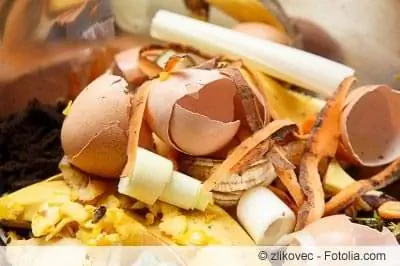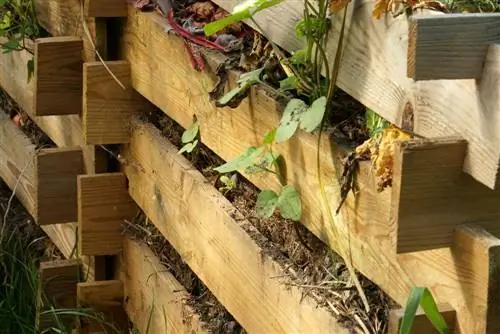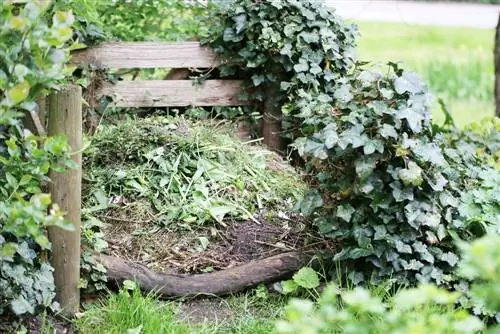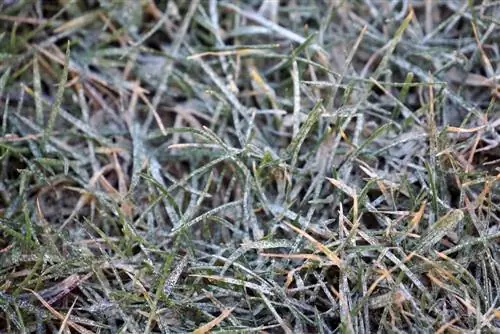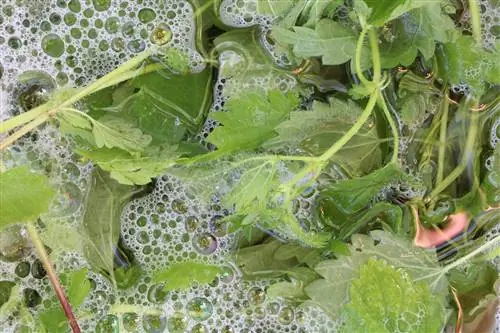- Author admin [email protected].
- Public 2023-12-17 03:39.
- Last modified 2025-06-01 06:48.
Egg shells are uncooked kitchen leftovers and therefore belong in the compost!? Unfortunately, the situation is not that simple. The fact is that the shell consists of 90 percent calcium carbonate - known as carbonate of lime. Lime has a wide range of uses in hobby gardens, for example in compost or as fertilizer for plants. The problem is that lime does not dissolve easily in this form. Are chicken egg shells helpful or even harmful? The following pros and cons arguments will help you make your decision.
This is how the proponents argue
The extensive positive influences of compost on plant growth and soil conditions have long been internalized by nature-loving hobby gardeners. Even in the smallest garden there is now a compost heap that is carefully filled with plant waste and uncooked kitchen leftovers. For decades, eggshells have also been thrown into the compost without much hesitation, for the following reasons:
- Egg shells contain valuable lime, an indispensable component of organic fertilizer
- maximum 0.5 millimeters thick, when crushed they promote the circulation of oxygen in the compost heap
- Calcium carbonate as the main ingredient neutralizes the acidifying effect of other additives, such as coffee grounds
- The carbon contained prevents excessive nitrogen formation and thus ensures stable humus development
Regarding concerns about pathogens on eggshells, advocates of composting point to the rotting process. A freshly created compost heap starts with a hot phase, with temperatures reaching 60 °C and more. In this stage, the organic material is broken down, although the pathogens do not survive this sanitation. Bacteria are also destroyed at a temperature of 70 °C. The advancing microorganisms ultimately find a biologically 'purified' material.
Tip:
In a thermal composter, the high temperatures are maintained permanently during the summer, which intensifies the hygienizing effect. The composting process is significantly accelerated.
The Contra Arguments

Within the large community of committed hobby gardeners, a faction is increasingly establishing itself that advocates adding eggshells to organic waste and not compost. Your evidence in detail:
- The shells of chicken eggs are not an organic mass, but rather a mineral composition
- Soil creatures avoid the crystalline solid instead of at least nibbling it
- Instead, eggshells undergo similar weathering processes to limestone
- as crushed splinters, they only visually disappear from view due to the brown discoloration
- Poultry egg shells are infected with salmonella that survive hot rotting
- the bacteria are distributed in the garden with the compost and end up in the food
- Flies pick up salmonella from organic material and transport it into the kitchen
With regard to the hygienising effect in the thermal composter, the opponents of eggshells as compost support their conviction as follows: What is the point of stable components that do not decompose anyway? Sooner or later they will be screened out and end up in the organic waste bin.
Rapid dissolution only in vinegar and hydrochloric acid
Calcium carbonate is constructed so robustly that it only dissolves quickly when vinegar or hydrochloric acid comes into play. A popular experiment in schools examines how to peel a raw egg. For this purpose, a commercially available, uncooked poultry egg is placed in a jar with vinegar essence. Within a short time, bubbles begin to form and foam develops on the surface of the liquid. Overnight the eggshell completely dissolves while the egg itself remains intact and has transformed into a 'rubber egg'.
As fertilizer for plants on the decline
The topic of eggshells as compost leads seamlessly to the question of their fundamental function as fertilizer for plants. Our grandparents and great-grandparents mixed the peels into the irrigation water or worked them into the bed soil; firmly convinced that their plants received an extra dose of lime. However, our ancestors lacked evidence. When modern methods were used to take a closer look, the problem of the low solubility of calcium carbonate became apparent. Since the general lime content of tap water has increased significantly in the meantime, most garden plants receive a sufficient amount of it - whether eggshells are added or not.
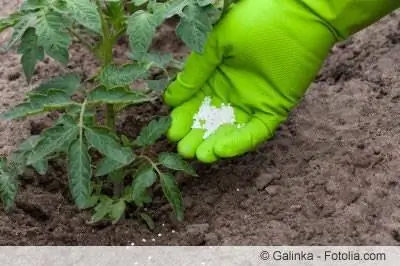
Alternatives to eggshells as fertilizer
In view of the slow solubility of the lime-containing component, effective alternatives are used for fertilizing lime-loving plants. As experience shows, the garden soils in German hobby gardens are usually well supplied with lime. If a pH soil test shows that the value drops too much towards acidic, countermeasures are necessary. This is particularly true when cultivating plants that prefer neutral to alkaline soil. These include, for example, forsythia, gladioli, daffodils, peonies and tulips in the ornamental garden as well as carrots, parsley, chard and some types of cabbage in the kitchen garden. This is how you proceed with liming:
- Classic garden lime is suitable for light to medium soils
- Ideally apply garden lime in autumn or winter
- On light sandy soil, the application of lime marl with 30 percent clay content is advisable
- Lime marl is spread in autumn due to its slow effect
- If additional nutrients with magnesium, manganese or boron are desired, algae lime is an option
- Seaweed lime is administered throughout the entire growing season
Rock dust occupies a special position. This contains plenty of carbonated lime, as well as magnesium and potassium. The nutrients, however, have to take a detour via the microorganisms so that they are available to plants. Then, however, the positive effects - depending on the source rock - are hard to beat. For example, earthworms and other soil organisms are activated, which promotes humus formation.
Tip:
If you repeatedly add rock dust to the compost heap, under normal conditions there is no need to immediately lime the bed soil.
Plants intolerant to lime
Fertilization with lime or eggshells is not always indicated. Various ornamental and useful plants only thrive optimally if they are cultivated in lime-poor to acidic soil. The best known representatives are:
- Rhododendron
- hydrangeas
- Petunias
- Azaleas
- Orchids
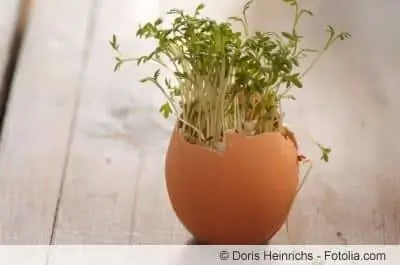
Various varieties of these genera are so sensitive to limescale that they should preferably be watered with collected rainwater because tap water is too hard.
Conclusion of the editors
The question of the usefulness of eggshells as compost and fertilizer for plants continues to be controversial. Both sides throw together convincing and less convincing arguments. There is certainty regarding the slow solubility of calcium carbonate in the shells of chicken eggs, meaning that adding them to irrigation water as fertilizer is unnecessary. All other arguments for and against either lack a scientific basis or simply lack experience. The answer to using poultry egg shells in the allotment garden is therefore more of an individual policy.
What you need to know about eggshells as fertilizer
In most cases, our grandparents used raw eggshells for fertilization. They either added the shells to the irrigation water or they chopped them up and then mixed them into the soil. This trick is still often recommended today. The eggshells contain calcium carbonate.
- Basically, these days there is hardly any point in adding additional lime to the soil in this way.
- In many areas of our country, the tap water is already quite calcareous. This means that all plants get enough lime.
- Very few plants need an additional supply of lime.
- On the contrary, for many of them too much lime or lime is actually rather harmful.
- If you have lime-free soil and fairly soft water, you can use eggshells to add lime.
- However, the eggshells produced in a normal four-person household are usually only sufficient for small areas or for flower pots.
- It takes a lot of eggshells to fertilize an entire garden. In addition, it is still a one-sided fertilizer.
- In addition, it takes some time for the shells to begin to decompose. So the effect doesn't set in as quickly.
Which plants don’t like lime?
- Rhododendrons, azaleas, heather, irises and all ericaceous plants.
- Also blueberries, cranberries, mock berries (Gaultheria).
- King fern, gorse, juniper (Juniperus communis).
- Bird cherries (Prunus padus), mountain ash and pine trees.
- Also peaches, wine, magnolias, sweet chestnuts.
Which plants love lime?
- Christmas roses, early spring cyclamen, daphne.
- Winter aconites, pasque flowers, liverworts, lilacs.
- Pipe bush, chives, lavender, outdoor hibiscus.
- Dark spurs, carnations, geraniums, bluebells and many more.
- Beans and peas in particular enjoy a little additional lime in the soil.
Pros and Cons
There are different opinions on whether you should add eggshells to the compost, depending on the latest scientific findings. In general, it is no longer recommended because flies can spread salmonella from compost to open food in the kitchen. When you add eggshells to the compost, they have plenty of time to slowly decompose and release their nutrients. The peels should be chopped well beforehand. The smaller the pieces, the better. In addition, the shells should not be left open on top of the compost heap, but should be covered (flies).

